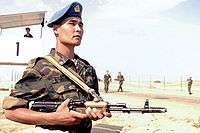Armed Forces of the Republic of Kazakhstan
| Armed Forces of the Republic of Kazakhstan Қазақстанның Қарулы Kүштері | |
|---|---|
|
Coat of Arms of the Kazakh Armed Forces | |
| Current form | 1992 |
| Service branches |
Republican Guard Kazakh Ground Forces Kazakh Air Force Kazakh Air Defense Forces Kazakh Naval Forces |
| Headquarters | Astana, Almaty |
| Leadership | |
| Commander-in-Chief | Nursultan Nazarbayev |
| Minister of Defence | Imangali Tasmagambetov |
| Manpower | |
| Military age | 18–45 years old; |
| Conscription | One year |
| Active personnel | 39,000 (IISS 2013) |
| Expenditures | |
| Budget | $1.648 billion U$D (FY11)[1] |
| Percent of GDP | 1.1% (2010 est.)[1] |
| Industry | |
| Domestic suppliers | JSC National Company Kazakhstan Engineering |
| Foreign suppliers |
|
| Related articles | |
| History |
Civil war in Tajikistan Iraq War |
The Armed Forces of the Republic of Kazakhstan (Kazakh: Қазақстанның Қарулы күштері, Qazaqstannıñ Qaruwlı küşteri, قازاقستاننىڭ قارۋلى كٷشتەرٸ), is the name of the unified armed forces of Kazakhstan. It consists of the Ground Forces, Air and Air Defence Forces, Naval Forces, and Republican Guard. The national defence policy aims are based on the Constitution of Kazakhstan. They guarantee the preservation of the independence and sovereignty of the state and the integrity of its land area, territorial waters and airspace and its constitutional order. The armed forces of Kazakhstan act under the authority of the Kazakhstan Ministry of Defence.
The Military Balance 2013 reported the armed forces' strength as; Army, 20,000, Navy, 3,000, Air Force, 12,000, and MoD, 4,000. It also reported 31,000 paramilitary personnel.[2]
Kazakhstan, alongside Uzbekistan, has a decent and well-equipped military for the region.
History
On May 7, 1992, the President of Kazakhstan took a number of actions regarding defence. He signed a decree on the 'establishment of the Armed Forces of the Republic of Kazakhstan', the transformation of the State Committee of Defence of the Republic of Kazakhstan into the Ministry of Defence, on the attribution of Sagadat Nurmagambetov the military rank of Colonel General, and the appointment of General-Colonel Sagadat Nurmagambetov as Defence Minister of Kazakhstan. Mukhtar Altynbayev served as the Minister of Defence twice, most recently from December 2001 to 10 January 2007.
On June 30, 1992, the Soviet Armed Forces' Turkestan Military District disbanded, following the collapse of the Soviet Union. The most powerful grouping of forces from the Turkestan Military District then became the core of Kazakhstan's new military. Kazakhstan acquired all the units of the 40th Army (the former 32nd Army) and part of the 17th Army Corps, including 6 land force divisions, storage bases, the 14th and 35th air-landing brigades, 2 rocket brigades, 2 artillery regiments and a large amount of equipment which had been withdrawn from over the Urals after the signing of the Treaty on Conventional Armed Forces in Europe.
On July 6, 2000, a Presidential Decree "On the structure of the Armed Forces of the Republic of Kazakhstan" changed the structure: The Armed Forces returned to a dual structure (general-purpose forces and air defense forces). The Airmobile Forces were created, the transition to the new military-territorial structure, established military districts, harmonized structure and deployment of troops. On August 7, Lieutenant-General A. B. Dzharbulov was appointed commander of the Southern Military District and Lieutenant-General E. Ertaev became commander of the Eastern Military District.
In February 2001 a Presidential Decree divided the functions of the Ministry of Defence and General Staff. According to the decree, the head of the General Staff subordinates all kinds of aircraft and type of troops and military districts, while the Minister of Defence has a mostly administrative and political functions. On March 30, Major General M. K. Sihimov was appointed commander of the Western Military Region. On October 12, M. Saparov was appointed to Chief of the General Staff and First Deputy of the Defence Minister. V. B. Elamanov became commander of the Airmobile Forces. On December 8, a new Defense Minister was appointed: General K. Altynbayev, and on December 27, Major General K. K. Akhmadiev was appointed commander of the Air Defense Forces.
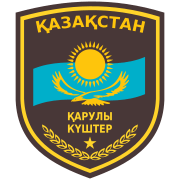

Key defense posts announced early in 2002 included; Major-General Tasbulatov appointed Deputy of the Defense Minister, Maj. Gen. Elamanov commander of the Southern Military District, Maj. Gen. N. А. Dzhulamanov commander of the Eastern Military District, Maj. Gen. Zhasuzakov commander of the Airmobile Forces, Major-General A. Shatskov commander of the Central Military District and K. Altynbayev given the title of Army General.
Kazakhstan had its first military parade in its history at Otar military base on May 7, 2013, celebrating the Defender of the Fatherland Day as the national holiday for the first time ever. During the ceremony, the first woman was promoted to the rank of General.[3]
Today there are four regional commands: Regional Command Astana, Regional Command South at Taraz, Regional Command East at Semipalatinsk, Regional Command West at Aktobe, as well as the Air Defence Forces, the Airmobile Forces with four brigades, and the Artillery and Missile Forces (formed as a separate branch on 7 May 2003).[4]
Kazakhstan is a founding member of CSTO and SCO. Kazakhstan also has an Individual Partnership Action Plan with NATO & strategic cooperation with the Turkish Armed Forces.
Ground Forces
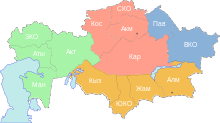
The 32nd Army had been serving in Kazakhstan for many years. The 32nd Army had been redesignated initially the 1st Army Corps (1988), then the 40th Army (June 1991). It came under Kazakh control in May 1992. On November 1, 1992, on the basis of units of the former Soviet 40th Army of the Turkestan Military District, the First Army Corps was created, with its headquarters in Semipalatinsk.[5] Later, at its base was established the Eastern Military District, retitled on 13 November 2003 as Regional Command East.
Immediately prior to its dissolution, the 40th Army consisted of the 78th Tank Division (Ayaguz); the 5202nd Base for Storage of Weapons and Equipment at Semipalatinsk (prior to 1989 – the 71st Motor Rifle Division); the 5203rd BKhVT Ust-Kamenogorsk (prior to 1989, the 155th Motor Rifle Division); the 5204th BKhVT at Karaganda (prior to 1989 – the 203rd Zaporozhye Khingan Motor Rifle Division), taken over by Kazakhstan on 7 May 1992, the 69th Tank Division (mobilisation) (Ust-Kamenogorsk), and the 10th Fortified Area.[6] The 69th Tank Division and the 10th Fortified Area were both disbanded in 1992.
In the middle of the 1990s Kazakhstan's land forces included the 1st Army Corps (HQ Semipalatinsk), with the 68th Motor Rifle Division (Sary-Ozek, in Kyzylorda Province) – 2 motor-rifle and one tank regiment and the 78th Tank Division (Ayaguz).[7] While the 68th Division was called a motor-rifle formation, in equipment terms it had almost 300 tanks and about 500 armoured fighting vehicles. The 78th Tank Division had 350 tanks, 290 armoured fighting vehicles and 150 artillery pieces. The 210th Separate Training Center (a former motor rifle training division) had 6,000 soldier and officers and 220 tanks and 220 artillery pieces, so was a strengthened division. (It was often called the Division of Guards by Kazakh sources).
Some of Kazakhstan's officers have trained at the United States Military Academy at West Point.
Today the Ground Forces include four regional commands:[8]
- Regional Command "Astana" (Headquarters Karaganda) – the administrative boundaries of Akmola, Karagandy Province, Kostanay Province and North Kazakhstan. The command acts as the Supreme Commander's reserve. The commander of the district is Major General Vladimir Shatsky (as of April 2008). The District includes the 7th Separate Motor Rifle Brigade at Karaganda.
- Regional Command "East" (Headquarters Semipalatinsk) – in the administrative boundaries of East Kazakhstan and Pavlodar Province (Families, Ust-Kamenogorsk, George, and Ayagoz Usharalsky garrisons). Commander of the district is Lieutenant General Nikolai Pospelov (as of September 2008). The District has the 3rd Mechanized Division (formerly the 78th Tank Division) at Ayaguz, three (?) bases for storage of military equipment, 3rd Separate Motor Rifle Brigade at Usharal (Military Unit No.40398, formed on the basis of a motor rifle regiment of the 155th Motor Rifle Division), 4th Separate Motor Rifle Brigade at Novo-Akhmirovo, Ust-Kamenogorsk (Military Unit No.27943), a cannon artillery brigade, and an air defence missile brigade.
- Regional Command "West", (Headquarters Atyrau) – in the administrative boundaries of the West Kazakhstan Province, Aktobe Province, Atyrau Province and Mangystau Province. The main task is ensuring the integrity of state borders, territorial integrity, sovereignty and economic interests of Kazakhstan in the Kazakh sector of the Caspian Sea. In 2008, the commander of the district appointed general Alimzhan Kanagatovich Erniyazov. The District has separate motor rifle and artillery brigades.
- Regional Command "South", (Headquarters Taraz) – in the administrative boundaries of Almaty Province, Zhambyl Province, South Kazakhstan Province and Kyzylorda Province. The district's main task is ensuring security in the south-eastern borders of the country. In 2008, General Alikhan Brimzhanovich Dzharbulov was appointed commander of the district. The District includes the 4th Motor Rifle Division at Sary-Ozek in Almaty Province, the 5th Separate Motor Rifle Brigade (Taraz, Military Unit No.85395, 1,500 personnel), the 6th Separate Motor Rifle Brigade (Shymkent, Military Unit No.35748, with five motor rifle and tank battalions, two artillery battalions), a mountain battalion, and the 210th Training Center. The 206th Reserve Division was previously stationed in this command area.
There are also the Air Defence Forces, the Airmobile Forces with four brigades, and the Artillery and Missile Forces (formed as a separate branch on 7 May 2003).[4]
Airmobile Forces
The Airmobile Forces were formed by grouping the 35th Guards Air Assault Brigade with new brigades formed from previous Soviet units. The 35th Guards Air Assault Brigade arrived from Germany in April 1991, and was taken over by Kazakhstan in 1992. Near Karaganda was the 5204th Base for Storage of Weapons and Equipment, the remnants of a motor rifle division.[9] In 1998 two motorized rifle brigades were created from the former storage base. One of which was left near Karaganda, and another called 2nd Separate Motor Rifle Brigade and was relocated 200 kilometers to the north of Astana, which by that time was the capital, and for that reason ought to have a decent court garrison. No units were stationed in Astana (Tslinograd) during the Soviet period. In October 2003, the 36th Separate Air Assault Brigade was formed on the basis of the 2nd Motor Rifle Brigade. On the basis of Taldykorgan Motor Rifle Regiment, 173rd Sary Ozekskoy Motor Rifle Division, in April 2003 was formed the 37th Separate Air Assault Brigade.
- the 35th Guards Air Assault Brigade at Kapshagai,
- the 36th Air Assault Brigade at Astana,
- the 37th Air Assault Brigade at Taldykorgan
- the 38th Air Assault Brigade – Peacekeeping Brigade KAZBRIG at Almaty[8][10][11]
| Kazakh paratroopers | ||||||
|---|---|---|---|---|---|---|
|
Ground Forces Equipment
Tanks
| Name | Image | Country of origin | Variant | Quantity | Notes |
|---|---|---|---|---|---|
| T-72 |  | | T-72BA | 300[12] | |
Infantry Fighting Vehicles
| Name | Image | Country of origin | Variant | Quantity | Notes |
|---|---|---|---|---|---|
| BMPT | 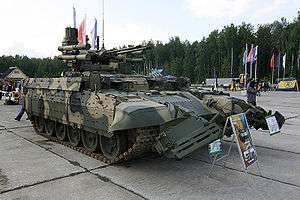 | | 10 | Purchased for evaluation. | |
| BMP-2 |  | | 500[12] | ||
| BMP-1 | Infantry Fighting Vehicle | | BRM | 60[12] | Used for reconnaissance. |
Armored Personnel Carriers
| Name | Image | Country of origin | Quantity | Notes |
|---|---|---|---|---|
| BTR-4 | Armored Personnel Carrier | | 0(+100) | 100 placed on order. |
| BTR-3E | Infantry Fighting Vehicle | | 2[12] | Purchased for evaluation, rejected in favor of BTR-4 |
| BTR-80A | Infantry Fighting Vehicle | | 107[12] | Modernised BTR-80 |
| BTR-70 | Armored Personnel Carrier | USSR | 190 | All in reserve. |
| BTR-60 | Armored Personnel Carrier | USSR | 150 | All in storage. |
| Marauder (vehicle) | Armored Personnel Carrier | South Africa | +0 | Contract Sighed for domestic production. |
| GAZ-2330 | Armored Personnel Carrier | Russia | 130 | |
| Otokar Cobra | Armored Personnel Carrier | Turkey | 30 | |
| HMMWV | Armored Personnel Carrier | USA | 45 69 114[13] | Purchasing since 2002 |
| BPM-97 | Armored Scout Car | Russia | 80 | |
| BRDM-2 | Armored Scout Car | USSR | 40 | All in reserve. |
| MT-LB | Armored Field Support Carrier | USSR | 680 | Only 200 are operational the rest are kept in reserve. |
| BTR-50 | Armored Field Support Carrier | USSR | 150 | All in storage. |
Other Vehicles
| Name | Type | Country of origin | Quantity | Notes |
|---|---|---|---|---|
| OTR-21 Tochka | Tactical Ballistic Missile | USSR | 12 | With 45 missile for the 12 operational units. |
| Naiza | Multiple Rocket Launcher | Israel/Kazakhstan | 380 | A Kazakh Israeli cooperation to create a highly nimble and mobile unit that can take both the 122 mm and 220mm rocket pods, designed to replace the BM-21 and BM-27.[14] |
| TOS-1 | Multiple Rocket Launcher | Russia | 3 | Purchased for evaluation. |
| M-1985 | Multiple Rocket Launcher | North Korea | 13 | Purchased for evaluation only during 1990s. |
| BM-30 Smerch | Multiple Rocket Launcher | USSR | 15 | All units active. |
| BM-27 Uragan | Multiple Rocket Launcher | USSR | 180 | Most are now in reserve. |
| BM-21 Grad | Multiple Rocket Launcher | USSR | 190 | Most are now in reserve. |
| BM-14 | Multiple Rocket Launcher | USSR | 80 | All are in storage. |
| 2S3 Akatsiya | Self-propelled Artillery | USSR | 89 | |
| Semser | Self-propelled Artillery | Israel/Kazakhstan | ? | To replace 2S1.[15] |
| 2S1 Gvozdika | Self-propelled Artillery | USSR | 74 | Most are now in reserve. |
| 2S4 Tyulpan | Self-propelled Mortar | USSR | 19 | |
| 2S9 NonaS | Self-propelled Mortar | USSR | 26 | |
| 152 mm howitzer 2A65 | Towed Artillery | USSR | 90 | |
| 2A36 | Towed Artillery | USSR | 180 | |
| 152 mm towed gun-howitzer M1955 (D-20) | Towed Artillery | USSR | 74 | |
| 122 mm howitzer 2A18 (D-30) | Towed Artillery | USSR | <400 | |
| T-12 antitank gun | Towed AT Gun | USSR | 125 | |
| 120mm 2B11/M-120 | Towed Mortar | USSR | 145[16] | |
| SA-10 | Long Range Air Defense | USSR/Russia | ? | Modernized by Russia in the middle of 2000s. |
| SA-5 | Long Range Air Defense | USSR | 27 | All are retired, in storage. |
| SA-6 | Medium Range Air Defense | USSR | 20 | |
| SA-4 | Medium Range Air Defense | USSR | ? | All are retired, in storage. |
| SA-3 | Medium Range Air Defense | USSR | ? | All are retired, in storage. |
| SA-2 | Medium Range Air Defense | USSR | 100 | All are retired, in storage. |

Small Arms
- 9×18mm Makarov PM Standard issue pistol for armed forces.
- 9×18mm PP-90M1 Submachine gun, used by special forces.
- 5.45×39mm AK-74 Standard issue rifle of Kazakh military.
- 5.45×39mm RPK-74
- 7.62×39mm AKM Reserve units
- 7.62×54mmR SVD Dragunov sniper rifle
- 7.62×54mmR PKM machine gun
- 7.62×54mmR PKP Pecheneg machine gun, used by special forces.
- 7.62×39mm ARX-160 Assault rifle, used by special forces[17]
- 12.7mm NSV machine gun
Security agencies and commando units
There are a number of special forces units reporting to various Kazakh security agencies which are not part of the Armed Forces. The National Security Committee of the Republic of Kazakhstan has the Arystan commando unit, KNS' Border Guards has a unit, the Police have units, and the Presidency is reported to have its own units as well.
Additionally, a small Republican Guard exists, with 2,500 soldiers (1994), but this force is not considered a part of the Army. The Republican Guard was established on March 6, 1992, when the President of Kazakhstan signed a decree on their creation. The Republican Guard was established on the basis of a separate brigade of operational designation of the Internal Troops deployed in the village of Kaskelen district of Almaty region.[18] Two Republican Guard regiments were created, stationed in Astana and Almaty.
Kazakh Air and Air Defence Forces
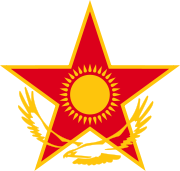
At the time of the dissolution of the Soviet Union, the 24th Fighter-Bomber Aviation Division with three aviation regiments and three separate regiments was stationed in Kazakhstan.[19] By late 1993 the Kazakhstan Air Force comprised a total of six regiments, with a further air defence fighter regiment. The 11th Division included the 129th Fighter-Bomber Regiment based at Taldy Kurgan, with MiG-27 'Flogger' aircraft and the 134th Fighter-Bomber Regiment at Zhangiz-tobe with MiG-27s. There was also the 149th Bomber Regiment at Zhetigen/Nikolayevka, with Sukhoi Su-24 'Fencers'. Independent elements comprised the 715th Fighter Regiment at Lugovaya, with MiG-29s and MiG-23 'Floggers'; the 39th Reconnaissance Regiment at Balkhash, with MiG-25RBs and Su-24MR 'Fencer' aircraft, and the 486th Helicopter Regiment based at Ucharal with Mi-24 'Hind'. The sole air defence fighter aviation regiment was the 356th Fighter Aviation Regiment at Semipalatinsk with MiG-31 air defence fighters. The Air Force was under the command of Major General Aliy Petrovich Volkov.
The 134th Fighter-Bomber Aviation Regiment at Zhangiz-tobe had originally been activated at Cherlyany, Lvov Oblast, in 1971, before being transferred to Central Asia that same year.[20] It was equipped with MiG-17s, MiG-21s, and the MiG-23UB up to 1981, when it was reequipped with the MiG-27D/M/K. Two squadrons were deployed to Shindand, Afghanistan from 22 October 1988 to 6 February 1989 (joined by one squadron from the 129th Fighter-Bomber Aviation Regiment). In early (January?) 1992, it was taken over by Kazakhstan, and disbanded in 1993. From 1980 to 1992 it was under the control of the 24th Fighter-Bomber Aviation Division which, according to Holm, also controlled the 129th Regiment in 1990. The 24th Division was itself subordinated to the 73rd Air Army, September 1970 – April 1980, the Air Forces of the Central Asian Military District, April 1980 – May 1988, and then to the 73rd Air Army once more from May 1988 to January 1992.
Air Force 12,000 (incl Air Defence) 1 air force division. Pilots fly approximately 100 hours per year.
Today the Kazakh Air and Air Defence Force has four fast jet bases:[21]
- 600th Guards Air Base, Zhetigen, Nikolayevka, Almaty, with MiG-29s and Su-24s,
- 602nd Air Base, Chimkent, with MiG-29,
- 604th Air Base, Taldykorgan Airport, with MiG-27s and Su-27s (previously the 129th Fighter-Bomber Regiment)
- 610th Air Base, Sary-Arka Airport, Karaganda, with MiG-31s,Su-27s,Su-25s.
Aircraft

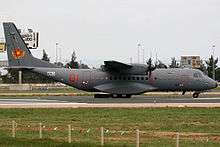
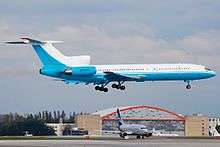
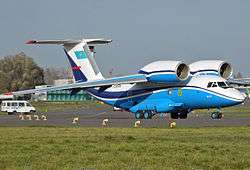
Current inventory
| Type | Origin | Role | Variant | In service | Notes |
|---|---|---|---|---|---|
| Combat Aircraft | |||||
| MiG-23 | Soviet Union | fighter | 3[22] | ||
| MiG-27 | Soviet Union | fighter bomber | 12[22] | ||
| MiG-29 | Russia | multirole | 39[22] | ||
| MiG-31 | Soviet Union | interceptor | 29[22] | ||
| Su-24 | Soviet Union | fighter bomber | 25[22] | ||
| Su-25 | Soviet Union | attack | 14[22] | ||
| Su-27 | Soviet Union | fighter | 13[22] | ||
| Su-30 | Russia | fighter | Su-30SM | 4[23] | |
| Transport | |||||
| Tu-154 | Russia | VIP | Tu-154M | 1[22] | |
| An-12 | Ukraine | heavy transport | 1[22] | ||
| An-26 | Ukraine | transport | 5[22] | ||
| An-72 | Ukraine | heavy transport | 2[22] | STOL capable aircraft | |
| CASA C-295 | Spain | transport | C-295M | 5[22] | 3 on order |
| Tu-134 | Soviet Union | light transport | Tu-134A-3 | 1[22] | Version Balkany, Reg. UN-65683 |
| Yak-40 | Soviet Union | light transport | 1[22] | Reg. UP-87850 | |
| Helicopters | |||||
| EC145 | France | utility | 2[22] | ||
| Mil Mi-17 | Russia | utility | 46[22] | ||
| Mil Mi-24 | Russia | attack | 18[22] | ||
| Mil Mi-26 | Russia | heavy lift / transport | 18[22] | ||
| Mil Mi-171 | Russia | heavy lift / transport | 3[22] | ||
| Trainer Aircraft | |||||
| Aero L-39 | Czech Republic | jet trainer | 20[22] | ||
Surface-to-Air Missiles include:
- Almaz SA-5 Gammon
- S-300 missile systems
Future Purchases
On 28 Oct 2010, two strategic agreements signed today establish the framework for Eurocopter’s creation of a 50/50 joint venture with Kazakhstan Engineering Kazakhstan to assemble EC145 helicopters, along with the sale of 45 of these locally assembled aircraft for government missions in the country.[24] On 28 November 2011, Eurocopter delivered the first of six EC145s ordered to date by the Kazakh Ministries of Defence and Emergencies.[25] Deliveries are to continue through 2017.
| Kazakh Naval Force | |
|---|---|
|
Kazakh naval emblem | |
| Country | Republic of Kazakhstan |
| Size |
3,000 personnel 14 vessels |
| Insignia | |
| Navy Ensign |
 |
| Naval Jack |
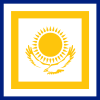 |
On 3 January 2012, Airbus Military signed a firm contract with Kazspetsexport, a state company belonging to the Ministry of Defence of Kazakhstan, to supply two EADS CASA C-295 military transport aircraft plus the related service support package for spare parts and ground support equipment. Additionally, a Memorandum of Understanding (MOU) has been signed for a further six C295 aircraft, for which separate firm contracts will be signed progressively over the next few years. The first two aircraft will be delivered by April 2013 and for the remaining six aircraft a delivery schedule will be defined over the following years. This purchase likely represents a quid pro quo. In 2008, EADS made titanium sourcing agreements with Kazakh suppliers.[26]
In May 2012, Kharkov Morozov (a Ukrainian company) agreed a $150 million contract with Kazakhstan Engineering to jointly produce 100 BTR-4 armored personnel carriers (APCs).[27] Deliveries were to begin in 2012, with 10 BTR-4s delivered. The remaining vehicles were to be delivered in 2013.
In May 2012, Kazakhstan signed a letter of intent to acquire 20 Eurocopter EC725 helicopters. They were to be assembled in Astana by Kazakhstan Engineering.[28] These Eurocoptors will be fitted with modern systems made by the Turkish firm Aselsan.
Naval Force
Kazakhstan’s Naval Forces were established by presidential decree on 7 May 2003. They operate on the Caspian Sea, based at Aktau. The Kazakh Naval Force has a strength of 3,000 personnel and is equipped with fourteen inshore patrol craft.[29]
Equipment includes:
- 1 Kazakhstan class missile boat – 250 ton, two more are planned[30][31]
- 4 Almaty class vessels
- 1 Dauntless class vessel
- 5 Guardian class vessels
- 2 Project 1400M Grif class patrol craft – 39 ton
- 2 Türk vessels
The naval aviation base in Aktau was opened eight years later, in 2011. The 612th Airbase in Aktau will provide the home for two Su-27 fighter jets, seven Su-27 pilots and twelve helicopter gunship pilots, according to a report in Interfax-Kazakhstan (not online, via BBC Monitoring). The report doesn't specify the model or number of helicopters, but it is presumed they are Mi-24s.[32]
References
- 1 2 "SIPRI Publications".
- ↑ IISS 2013, 221.
- ↑ "First Military Parade in Kazakhstan". The Gazette of Central Asia. Satrapia. 7 May 2013.
- 1 2
- ↑ For early information on Kazakhstan's land forces, see also 'Kazakhstan's Defence Profile Revealed,' Jane's Defence Weekly, 9 October 1993
- ↑ Michael Holm, 32nd Combined Arms Army, 2015.
- ↑ Machine translated and cleaned up from a Russian source at http://www.nomad.su/?a=2-200205081022, 'Military-political safety of Kazakhstan'
- 1 2 Most specific unit information, including military unit numbers, locations, etc. is sourced from Vad777, Kazakh Ground Forces Archived March 24, 2012, at the Wayback Machine., accessed February 2010
- ↑ History of the Airmobile Forces of Kazakhstan, http://desantura.ru/articles/23/?PAGEN_1=2
- ↑ Archived March 31, 2012, at the Wayback Machine.
- ↑
- 1 2 3 4 5 International Institute for Strategic Studies (IISS) (9 February 2016). "The Military Balance 2016". Routledge: 185–186. doi:10.1080/04597222.2016.1127558.
- ↑ "What Were American Humvees Doing In Zhanaozen?". eurasianet.org. 2012-01-24. Retrieved 2016-05-04.
- ↑ "Naiza". military-today.com. Retrieved 8 October 2015.
- ↑ "Semser". military-today.com. Retrieved 8 October 2015.
- ↑ IISS 2009 The Military Balance 2010, p365
- ↑ Kazakhstan Special Forces Adopt Beretta ARX-160 in 7.62x39mm – Thefirearmblog.com, May 8, 2013
- ↑ "Сегодня – День создания Республиканской гвардии". Retrieved 14 December 2014.
- ↑ Michael Holm, 24th Fighter-Bomber Aviation Division, accessed October 2011. Note division was given as the 11th in Kazakhstan AF Restructures, Jane's Defence Weekly, 25 September 1993
- ↑ Michael Holm, 134th Fighter-Bomber Aviation Regiment; Military Unit: 13764, accessed August 2011
- ↑ Vad777, Brinkster.net, July 2010
- 1 2 3 4 5 6 7 8 9 10 11 12 13 14 15 16 17 18 19 20 "World Air Forces 2015 pg. 21". Flightglobal Insight. 2015. Retrieved 20 July 2015.
- ↑ "Kazakhstan to acquire Su-30SM fighters". janes.com. Retrieved 8 October 2015.
- ↑ "HeliHub Kazakhstan buys 45 EC145s and signs production JV with Eurocopter". Retrieved 14 December 2014.
- ↑ "HeliHub First of six EC145s deliverd to Kazakhstan". Retrieved 14 December 2014.
- ↑ Defense Industry Daily, EADS-Signs-its-Own-Titanium-Deal-with-Kazakhstan
- ↑ "Kazakh Defense Exhibit Features Helo, Vehicle Deals". Defense News. Retrieved 14 December 2014.
- ↑ "Airbus Group". airbusgroup. Retrieved 8 October 2015.
- ↑ "Military Balance in Europe 2011"., March 07, 2011
- ↑ "Министерство обороны Республики Казахстан (МО РК)". mod.gov.kz. Retrieved 8 October 2015.
- ↑ "Kazakhstan Navy Unveils Its First Ship". EurasiaNet.org. Retrieved 14 December 2014.
- ↑ "Military Balance in Asia 2011"., March 07, 2011, page 55-56
- CIA World Factbook, 2003 edition.
- Abai TASBULATOV, "The Kazakhstani Republican Guard: Its Record and Development Prospects", Military Thought, No. 4, 2009, pages 136–142
External links
- Journal of Power Institutions in Post-Soviet Societies, Issue 11, 2010, Security and Defense Reform in Post Soviet Central Asia
- Building National Armies – Kazakhstan
- Kazakh armored forces parade

